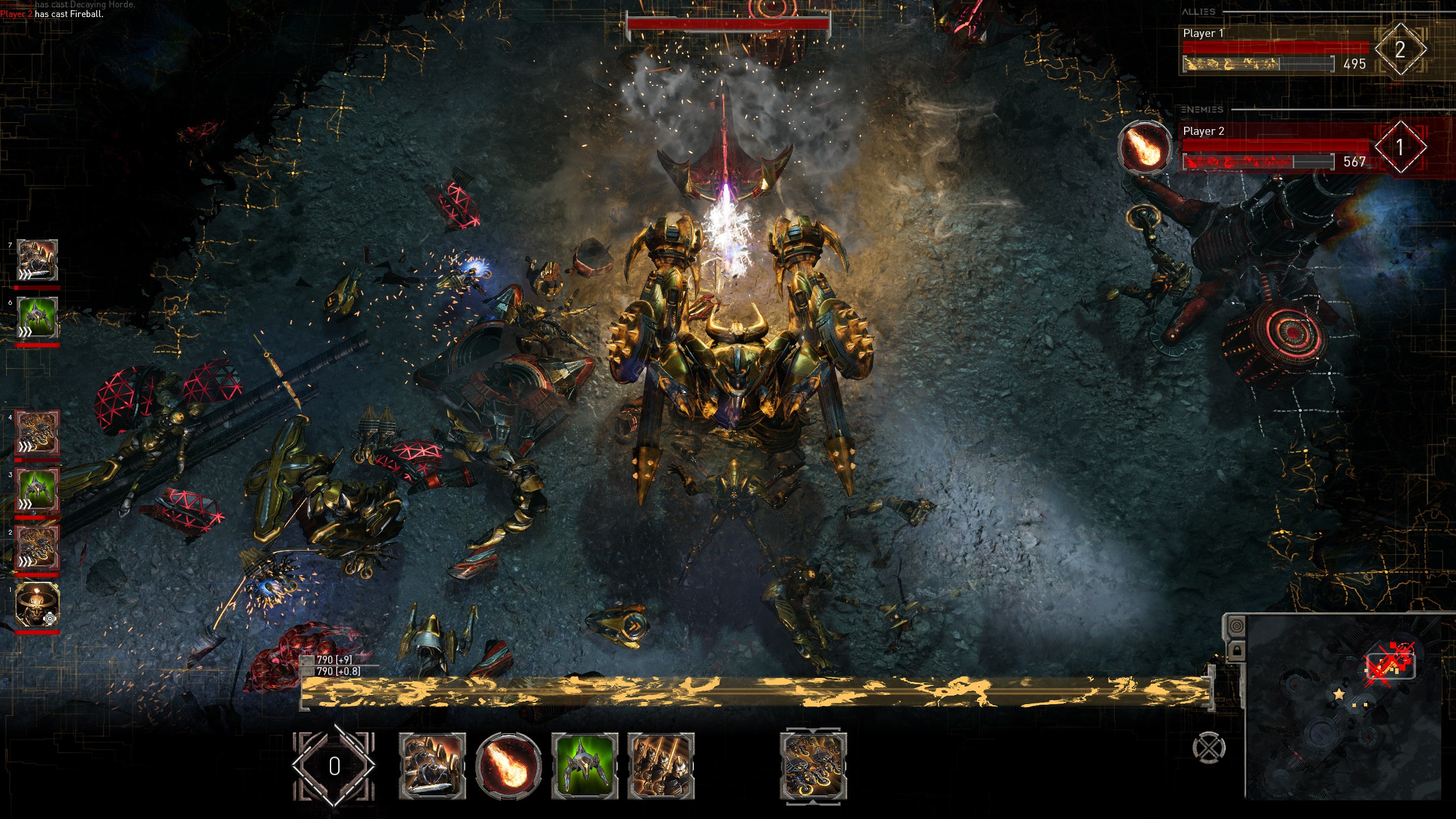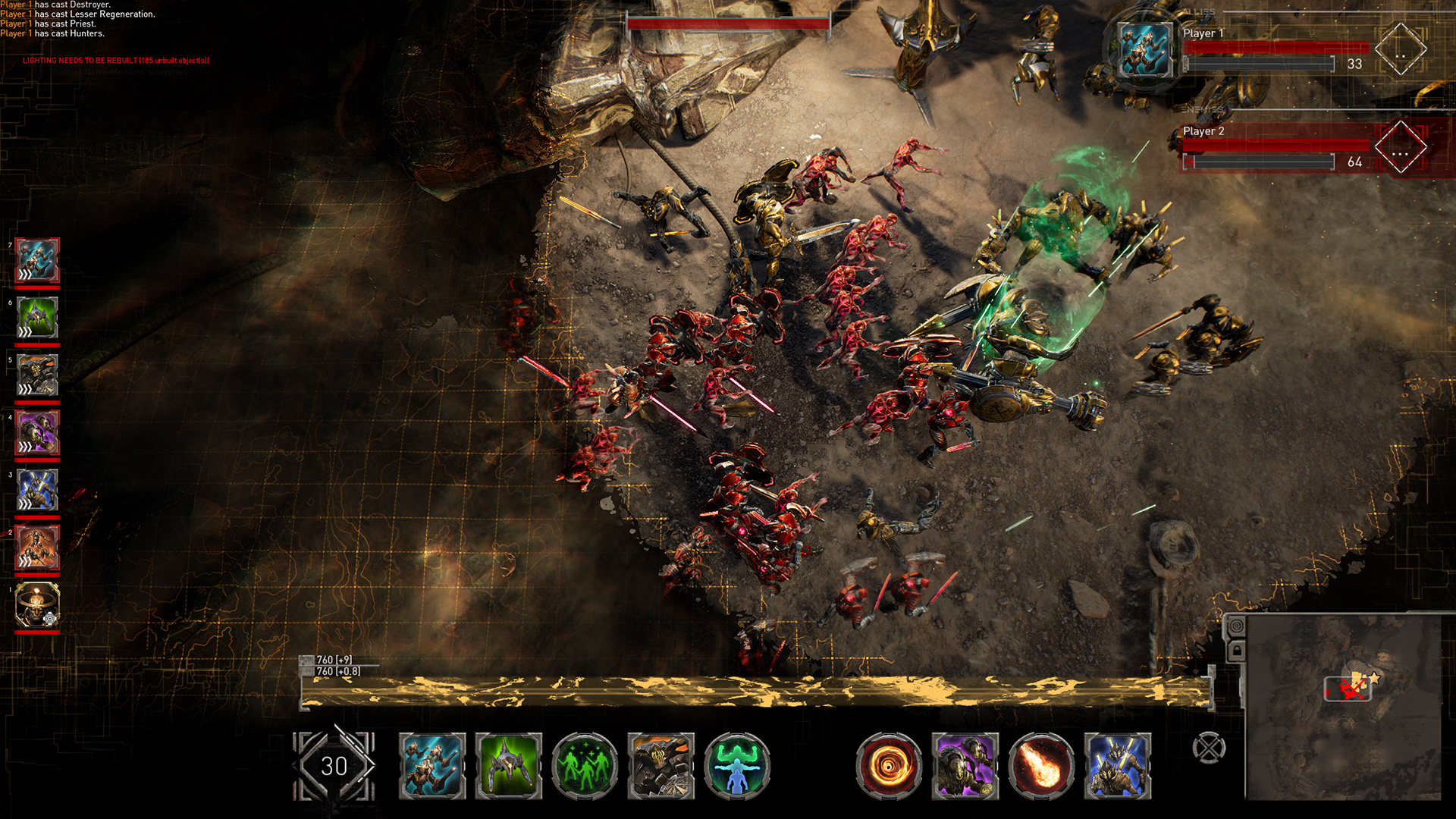Search
[{{{type}}}] {{{reason}}}
{{/data.error.root_cause}}{{{_source.title}}} {{#_source.showPrice}} {{{_source.displayPrice}}} {{/_source.showPrice}}
{{#_source.showLink}} {{/_source.showLink}} {{#_source.showDate}}{{{_source.displayDate}}}
{{/_source.showDate}}{{{_source.description}}}
{{#_source.additionalInfo}}{{#_source.additionalFields}} {{#title}} {{{label}}}: {{{title}}} {{/title}} {{/_source.additionalFields}}
{{/_source.additionalInfo}}- Details
- Category: Computer
- By Sam George
- Hits: 4125
Golem Gates (PC)

Golem Gates
Developed by: Laser Guided Games
Published by: Laser Guided Games
Release date: March 28, 2018
Available on: Windows
Genre: Real-time Strategy
Number of players: Single player, up to 4 players competitive/cooperative online
ESRB Rating: Not rated
Price: $29.99
Thank you, Laser Guided Games, for sending us a review key!
Golem Gates sets out to twist two common traits of the real-time strategy (RTS) genre: games are too predictable, and games are too slow. To mitigate the issue of predictability, Golem Gates borrows card battle tropes with abandon. To speed things up, the game uses point-control resource collection and unit placement anywhere the player has vision. Golem Gates is designed to get around problems in an entrenched genre; as such, it largely assumes the player is familiar with the interface, statistics, and controls of its older genre siblings. If you are willing to learn a little, Golem Gates appeals to genre newcomers and veterans through its streamlined gameplay. Whatever your previous experience, this game messes with genre conventions and pays the price in the form of new problems. It’s interesting; it’s experimental; it feels repetitive eventually. I’m not sure that everything Golem Gates tries works, but the effort is appreciated.
In most RTS games, the player collects resources to construct soldier units to destroy enemy units. Such is true in Golem Gates, sort of. The game is played from a bird’s eye view, but the player is also present on the battlefield in the form of a “Harbinger,” a powerful humanoid who, much like the king in chess, is the most important unit; lose it, and you lose the match. The player can summon units anywhere on the map that there is clear vision, removing the need for production structures. This keeps most of the tactical decisions at the points of conflict and, unless your deployed army gets wiped, removes the need to truck units across the map in the middle of a match. Unit construction is limited by the Harbinger’s energy bar, which slowly increases over the course of the match and depletes whenever a unit or spell is used. The energy maximum grows over the course of the match. The most powerful units cannot be produced early, and the matches have rising tension, stakes, and fireworks.
Energy production is tied to control points across the map. Holding them refills the energy bar faster, thus allowing steadier unit construction. The early game is primarily composed of pushes to control these points. Golem Gates does not allow players to stockpile an army at the start of the match to prepare a devastating rush on the enemy; energy gain is simply too slow if you do not commit to control points.

Strong Points: Improvisation-heavy and fast-paced real-time strategy (RTS) gameplay; decent amount of single-player content with good mission variety; detailed statistics on each unit informs deck-building and play decisions; good variety of unit types
Weak Points: Unit construction cooldown can stretch matches after the outcome is obvious; lack of multiplayer community; some pathfinding issues
Moral Warnings: Sentient robotic creatures attack each other with swords, guns, and energy
Energy production and control points are designed to give matches a fast pace. In short, they succeed. Control point locations are always visible on the map, along with their current owner, so you never have to wonder where the fight is. On-site unit construction keeps battles lively. Knowing that the enemy can also spawn a giant mech wherever they have a single scout keeps you on your toes with an eye on your backline and Harbinger. On the downside, energy production in the late game is sometimes too slow if you need to replenish a large force. Maybe you have strong units guarding each of the control points, but the army you’re using to assault the enemy leader got destroyed by a few strong fireball spells. The enemy is behind a wall of turrets and cannons, so you need a sizeable force to break in and finish him off. The best course of action is to slowly stockpile a new army while the energy bar creeps up and drops down again with every unit you create. This has not often been a problem, but it is an issue inherent in the energy system: battles can continue long after the final result is certain.
Thus far Golem Gates is an RTS with a brisker match pace. Now we add card game mechanics, and the game gains deckbuilding and forced improvisation. Every spell and unit is summoned with a glyph (essentially a card) from the deck you construct outside of a match. At the start of the match, you are given six glyphs and allowed to mull (switch out for a random different glyph) any, all, or none of them. Then, at fixed intervals during the match, you draw a new glyph from your deck. When your deck runs out, you can choose to take several seconds of inaction to reshuffle. There are an impressive number of glyphs with wildly different effects and uses. Many are standard foot soldiers, different only in cost and strength. Other glyphs spawn stealthed scouts or kamikaze bombers. Some nullify enemy spells. Glyph structures might spit fire, heal, displace, or return units defeated in its radius to your hand. There are many hero glyphs which, while powerful, cannot be used again until the hero unit dies. Glyph traps can act as landmines or poison traps. Some glyphs simply draw more glyphs into your hand. The effects go on and on. The deckbuilding screen explains the glyphs well, and they each have their place. Alas, the start of the match is the place for few, and if the initial draw and mulligan does not get you cheap units to capture control points, you can easily fall behind early as the enemy captures points with units you simply don’t have the energy to counter. This is the biggest factor of randomness, and there does not seem to be an easy way to mitigate it.
This particular type of randomness is not a great issue in Golem Gates’s single-player offerings; you can simply restart the match. Campaign mode gives a tutorial and fifteen missions. They are simply structured but enjoyable enough, with map variety and regular rewards of new glyphs to take you along despite the incomprehensible, long, and boring pre-mission cutscenes. Some missions have you face an opposing leader in the field; most pit you against one of the eponymous Golem Gates, which function exactly like a leader (spawning enemies, defending itself) except that they do not move. I enjoyed campaign mode a good deal. Then I discovered the Trials, and the story missions haven’t seemed the same since.

Higher is better
(10/10 is perfect)
Game Score - 78%
Gameplay - 16/20
Graphics - 7/10
Sound - 7/10
Stability - 4/5
Controls - 5/5
Morality Score - 96%
Violence - 8/10
Language - 10/10
Sexual Content - 10/10
Occult/Supernatural - 10/10
Cultural/Moral/Ethical - 10/10
Trials is a challenge scenario mode. Those scenarios are almost as varied as the glyphs. To name a few: you spawn endless creep units and must escort them with structures and spells only; an ally Harbinger must be defended; you cannot draw glyphs and instead must collect them from the battlefield; one supercharged hero unit must be destroyed before it gets to you. You can build decks for specific challenges, giving them a puzzle feel. This is my favorite mode, and the story missions are a bit bland in comparison.
Survival mode is just what it sounds like: you must survive against an enemy onslaught for a set period of time. It is won by making tradeoffs between point control for energy and defense of the Harbinger. In survival mode, you can theoretically be joined by an ally, either random or from your Steam friend list. I say “theoretically” because it is possible that no one else is trying to play this game online at the moment. This is a shame, because Golem Gates clearly aims to be a competitive multiplayer game. There is a versus mode for 1v1, 2v2, and 4-player free-for-all matches on one of several maps. I’m sure it would be fun, if I could find an opponent. I could not. There are, fortunately, AI battles with a variety of maps and AI types. Even the enemy deck can be customized. If you enjoy the gameplay, there’s plenty to be had.
Moral issues are limited thanks to the mechanical nature of almost all the creatures in the game. The cutscenes attempt to present some scary imagery that is undercut by the uninspired voice acting. As games centered on fighting go, Golem Gates is remarkably clean and inoffensive. The game runs smoothly once you get the right setting on your computer. I had to tone down the beautiful hi-res graphics to ugly-yet-functional to prevent jittering and overheating. Once I did, the game ran with few issues. Units often have pathfinding problems beyond, “Why did you choose to go around that rock the long way?” In one story mission, units would get stuck for a time at an open door. In general, units struggle to stay within the radius of their friendly turret structures, choosing to take the fight out to the enemy where they can die without cover fire. It’s annoying, though not game-breaking.
There is nothing special about the soundtrack. Controls are standard, at least if you have played an RTS before. The game does not go out of its way to make all your control options obvious. Units can be grouped up, individually controlled, and set to use their special abilities automatically. The map can be scrolled and zoomed. There’s nothing unusual, but little things like this are not explained well and could take some experimentation to learn.
I would recommend Golem Gates to people who enjoy RTS games or think they might enjoy marching a small, varied army from skirmish to skirmish. I wish I could recommend it on the basis of its multiplayer potential; there just aren’t enough players for me to evaluate its viability as a competitive, changing multiplayer game. What Golem Gates does to distinguish itself, it does well. Where it stumbles, it does so because it is reaching for specific goals. If the online servers are never inhabited, you could still have a good time with this game for a while.








